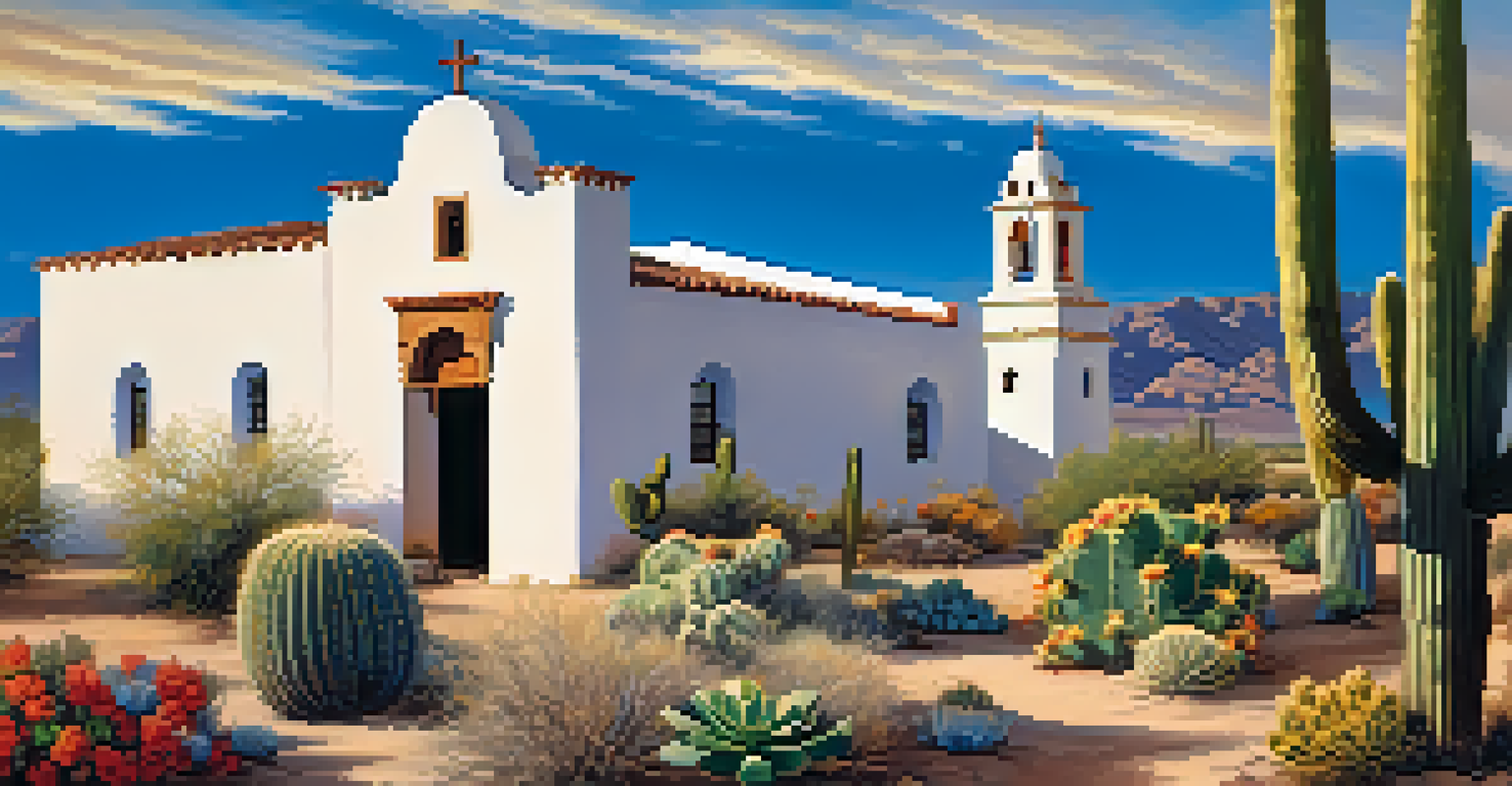Impact of Tourism on Arizona's Cultural Heritage Sites

The Allure of Arizona's Cultural Heritage Sites
Arizona is home to a wealth of cultural heritage sites, from Native American ruins to Spanish missions. These sites draw millions of tourists each year, eager to explore the state's rich history. The stunning landscapes and unique architecture make these locations not just educational but also visually captivating.
Preservation of our heritage is not only about maintaining the past but also about ensuring we have a future.
Tourists are often fascinated by the stories behind these sites, which reflect centuries of cultural evolution. However, the allure of these sites is not only for learning; it also plays a vital role in boosting the local economy. As visitors flock to experience Arizona's history, local businesses thrive, creating jobs and supporting community growth.
This influx of tourism can lead to a double-edged sword. While it brings economic benefits, it also raises concerns about the preservation of these historical treasures. Therefore, maintaining a balance between attracting visitors and protecting cultural heritage becomes crucial.
Economic Benefits of Cultural Tourism
Tourism is a significant economic driver in Arizona, particularly for cultural heritage sites. Visitors often spend money on tours, souvenirs, and local dining, directly benefiting the local economy. This economic boost supports not only the preservation of these sites but also the livelihoods of the surrounding communities.

Moreover, cultural tourism helps to fund restoration projects and conservation efforts. When tourists pay for entry to a site or participate in guided tours, a portion of those funds often goes towards maintaining the site's integrity. This creates a sustainable cycle where economic activity directly contributes to heritage preservation.
Cultural tourism boosts local economy
Tourism at Arizona's heritage sites significantly contributes to the local economy by creating jobs and supporting community growth.
Additionally, as more tourists visit, the demand for education and awareness about these cultural sites increases. This leads to greater investment in educational programs, ensuring that both locals and tourists understand the significance of what they are experiencing.
Challenges of Over-Tourism on Heritage Sites
While tourism can be beneficial, over-tourism poses serious challenges to Arizona's cultural heritage sites. High visitor numbers can lead to physical wear and tear on these fragile structures. For example, the footprints of countless visitors can erode ancient ruins, making preservation efforts increasingly difficult.
Cultural heritage is the foundation of our identity and the key to our future as a society.
Moreover, the experience for the visitor can be diminished when sites become overcrowded. Long lines and crowded spaces can detract from the immersive experience that these heritage sites are meant to provide. This highlights the importance of managing visitor numbers through sustainable tourism practices.
In response to these challenges, many sites are implementing strategies to mitigate the impact of over-tourism. This includes limiting access during peak times and enhancing visitor education to promote respectful behavior toward these cultural treasures.
Community Involvement in Tourism Management
Community involvement is crucial for the sustainable management of Arizona's cultural heritage sites. Local residents often have a deep understanding of the significance of these sites and can offer valuable insights into preservation efforts. Engaging these communities ensures that tourism is beneficial for both visitors and locals.
In many cases, indigenous communities are at the forefront of cultural tourism, sharing their traditions and stories with visitors. This not only empowers the local population but also fosters an authentic experience for tourists. When communities are included in the tourism conversation, it leads to more meaningful interactions.
Over-tourism threatens heritage sites
High visitor numbers can lead to deterioration and diminished experiences at cultural heritage sites, highlighting the need for sustainable tourism practices.
Furthermore, community-led initiatives can help in developing guidelines for respectful tourism. These initiatives often advocate for responsible visitor behavior, ensuring that cultural heritage sites are treated with the respect they deserve.
The Role of Technology in Cultural Preservation
Technology plays an increasingly important role in the preservation of cultural heritage sites in Arizona. Digital tools are being used to document and analyze these sites, providing valuable data for conservation efforts. For instance, 3D scanning technology can create accurate models of structures, aiding in restoration work.
Moreover, technology can enhance the visitor experience through virtual tours and interactive exhibits. This allows people to explore cultural heritage sites from anywhere, potentially reducing the number of physical visitors while still promoting awareness and appreciation. Imagine exploring the Grand Canyon's ancient history from your living room!
Additionally, social media platforms serve as powerful tools for raising awareness about the importance of these cultural sites. By sharing stories and images, tourists can contribute to a global conversation about preservation, encouraging others to respect and support these treasures.
Preserving Cultural Heritage for Future Generations
The preservation of Arizona's cultural heritage sites is essential for future generations. These sites not only reflect the history of the state but also serve as a source of identity for many communities. Ensuring their survival means that future generations will have the opportunity to learn from and connect with their past.
Sustainable tourism practices are vital in this respect. By promoting responsible visitor behavior and supporting local initiatives, tourists can help safeguard these sites. Simple actions, like staying on designated paths and respecting signage, can make a significant difference in preservation efforts.
Community involvement enhances preservation
Engaging local communities in tourism management fosters authentic experiences and promotes respectful behavior towards cultural heritage sites.
Ultimately, the goal is to create a legacy that honors the past while allowing for future exploration. By valuing these cultural heritage sites today, we pave the way for tomorrow's visitors to experience Arizona's rich history just as we do.
The Future of Arizona's Cultural Heritage Tourism
As tourism evolves, so too does the approach to cultural heritage tourism in Arizona. The future will likely focus on finding innovative ways to balance visitor engagement with site preservation. This means adapting to trends, such as eco-tourism and experiential travel, which emphasize sustainable practices.
Collaboration between tourism agencies, local communities, and preservation organizations will be crucial in shaping this future. By working together, stakeholders can create initiatives that respect cultural heritage while providing enriching experiences for visitors. This collaborative spirit can lead to more sustainable tourism models.

In conclusion, the future of Arizona's cultural heritage tourism lies in a shared commitment to preservation and education. By prioritizing these values, we can ensure that Arizona's rich cultural tapestry remains intact for generations to come.